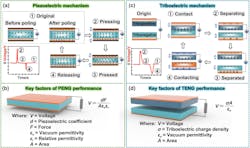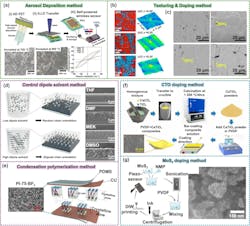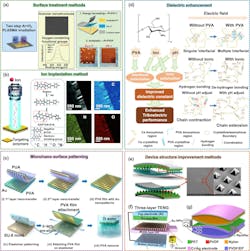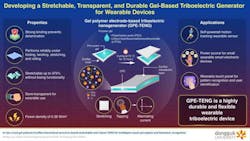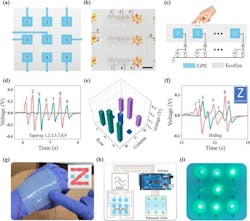Korean Researchers Advance Piezoelectric and Triboelectric Harvesting Sensors
What you’ll learn:
- How researchers are modifying basic materials to enhance and tailor transducer performance.
- Efforts and results achieved with piezoelectric materials.
- Efforts and results achieved with triboelectric materials, including “gel” varieties.
Many of the circuits, components, and software advances we rely on are made possible largely due to research efforts and results in behind-the-scenes materials science. While that discipline isn’t as glamorous or attention-getting as artificial intelligence (AI), for example, it’s what enables us to do many of things we desire using the resulting enhanced devices, substrates, packaging, and more.
Clear proof of this comes via two unrelated projects from researchers in the Republic of Korea (ROK—also known as South Korea). A brief look at their work in piezoelectric and triboelectric transducers, as well as self-powered transducers, shows the breadth and intensity of ongoing efforts
Start with basic sensors: Piezoelectric sensors leverage voltage generation through mechanical stress in non-centrosymmetric materials such as quartz and polyvinylidene fluoride (PVDF), while triboelectric sensors operate on contact-induced charge transfer. Both sensor types offer unique advantages, including self-powered functionality and high sensitivity. But they also face challenges, such as material brittleness and environmental limitations.
Improving Sensor Manufacturing: Materials and Fabrication Methodology
Recognizing these limitations and seeking to overcome them at least to some extent, a multi-institutional team led by researchers at Chung-Ang University (ROK) conducted a comprehensive review of manufacturing strategies for piezoelectric and triboelectric tactile sensors (Fig. 1). They focused on basic techniques to enhance sensitivity, flexibility, and self-powering capabilities. The study examined various material properties, fabrication processes, and device designs to overcome challenges like brittleness in piezoelectric materials and environmental sensitivity in triboelectric sensors.
For piezoelectric sensors, the researchers highlighted the importance of increasing the piezoelectric constant through methods such as doping, crystallinity control, and composite material integration (Fig. 2). Notable advances include using lead-free ceramics and polymer blends to create flexible, environmentally friendly, sensors that are suitable for dynamic applications. The integration of 3D printing and solvent-based crystallization techniques was also found to significantly improve the sensitivity and adaptability of these sensors.
The triboelectric sensors were enhanced through surface-modification techniques such as plasma treatments, microstructuring, and dielectric constant optimization (Fig. 3). These strategies increased charge-transfer efficiency and enabled the development of durable, high-output sensors. The researchers also demonstrated the effectiveness of hybrid materials and nanostructures in boosting triboelectric performance while maintaining flexibility and environmental resilience.
This work on enhanced triboelectric and piezoelectric sensors is detailed in their lengthy (23 pages) yet highly readable paper “Manufacturing strategies for highly sensitive and self-powered piezoelectric and triboelectric tactile sensors” published in The International Journal of Extreme Manufacturing.
A Tribo Flex
Also in the triboelectric area, researchers at Dongguk University (ROK) developed a novel in-situ-cured gel-polymer-electrode-based triboelectric nanogenerator (GPE-TENG) that’s stretchable, semi-transparent, and durable. It’s designed to enable a self-powered touch panel for intelligent touch perception.
They note that gel-based sensors for next-generation touch panels have been acknowledged for their exceptional sensitivity and flexibility. However, these sensors typically depend on a metal grid connection, which is susceptible to structural deformation under heavy stress applications and thus necessitates external power.
For their GPE-TENG, the in-situ curing of the hierarchical structure of the ionic polymer gel encapsulated within Ecoflex (a biodegradable and compostable plastic) ensures robust adhesion of the ionic conductive polymer gel (PEO/LiTFSI) to the Ecoflex layers. It addresses the issue of delamination in TENG components under mechanical stress.
To fabricate the device, the researchers poured a gel mixture of polyethylene oxide (PEO) and lithium bis(trifluoromethanesulfonyl)imide (LiTFSI) into the Ecoflex mold (Fig. 4). The gel is spread evenly and then covered with another Ecoflex layer. A copper wire is attached to the gel for electrical connection, and the entire assembly is cured at 70°C for 12 hours, allowing the gel to bond strongly with the Ecoflex layers.
The result is a durable, flexible, and semi-transparent device that generates electrical signals when tapped or stretched, delivering a peak power density of 0.36 W/m2 with a load of 15 MΩ. In tests, the device stretched up to 375% of its original size with no damage and could withstand two months of bending, twisting, folding, and stretching without any signs of delamination or loss of electrical performance.
The GPE-TENG generates electrical signals through simple device stretching, thus serving as a self-powered wearable sensor for human activity monitoring. To demonstrate its performance, they created a 3×3 (9-digit) flexible, semi-transparent, and self-powered touch-panel array based on the GPE-TENG (Fig. 5). This array showed multifunctionality including touch track/pattern recognition (touch and sliding mode) and a highly accurate (∼98%) deep-learning-assisted smart biometric system for user identification.
Their paper on the work “In-situ cured gel polymer/ecoflex hierarchical structure-based stretchable and robust TENG for intelligent touch perception and biometric recognition” was posted at Chemical Engineering Journal.

